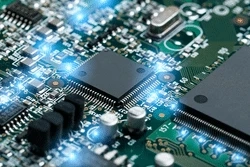To meet the specifications of the different aerospace, defense, or other high-reliability functions where the use of lead-free solders is prohibited due to tin whisker concerns, some ball grid array (BGA) equipment needs to be transformed from a lead-free finish, primarily from a SAC305 (Sn96.5/Ag3.0/Cu0.5) finish to a tin-lead (Sn63Pb37) finish.
De-balling, the initial stage of reballing BGA techniques and this conversion procedure, involves removing the original set of lead-free solder balls from the back side of the BGA device to reveal the interposer\'s pads.
Following this de-balling procedure, new solder spheres made of the replacement alloy are aligned, attached, and fluxed before being reflown, examined, cleaned, and tested before packaging.
It is advisable to use a robotic hot solder dip (RHSD) machine with a dynamic soldering wave and Sn63Pb37 solder to de-ball BGAs of SAC305 components.
There are single solder wave and twin solder wave robotic hot solder dip machines. The stripping procedure only requires one wave. The original SAC solder can be entirely removed by the dynamic solder wave and replaced with a fine margin of Sn63/Pb37 solder. Dual solder waves are normally not advised for BGA de-balling as a further thermal cycle could harm the BGA device. There wouldn\'t be much silver or copper left over from the initial SAC305 links.
Even though tin makes up most of SAC305, routine monitoring of the stripping pot is necessary to ensure that copper and silver contamination levels stay within the J-STD-001 permitted maximum of 0.10% and 0.02%, respectively. The leftover solder may also become contaminated if the alloy used in the stripping pot picks up lead-free solder contamination.
Using an RHSD machine fitted with a multiple-position arm, automated de-balling operations can be carried out on numerous BGA devices. This procedure entails the following steps:
- Using a multi-axis robotic system, automated vacuum collection of many BGA elements from a JEDEC matrix tray or a custom-made tray
- Application of flux to current BGA solder spheres
- Removing too much flux with an air knife
- Pre-heating cycle that may be programmed to turn on flux and warm up the BGA package
- Original solder balls are removed and flushed away using a dynamic solder wave.
- Flux residues are removed with an ultra-filtered, hot water rinse.
- BGA component drying using an air knife
- Returned to the matrix tray after being deballed
- Clean and examine BGA parts
Services for reballing BGA components are offered for BGA devices with a pitch as small as 0.35 mm. When reballing BGAs and other area array devices like land grid array (LGA) and the quad flat pack, with no leads (QFN) devices, there are several ways to attach the solder spheres, including solder paste deposition, utilizing sticky flux, and using new solder spheres. Services for reballing BGA components are offered for BGA electronics with a pitch as small as 0.35 mm.
When determining which approach is best, factors including device pitch, sphere diameter, package size ball count, and solder alloy must be considered. Since solder paste volume variability will affect the final spherical volume variability, the application of sticky flux is the most popular method. As a result, adding flux volatiles to the final sphere can increase voiding caused by sphere size and the paste.
Following the de-balling procedure, the following process stages are used to re-ball single or multiple BGA devices:
- BGA parts used in unique fixtures
- Applied flux to BGA pads
- Positioned above a BGA device is a precision aperture stencil.
- Solder new alloy spheres into the openings.
- Utilizing an IR oven or a multi-stage reflow oven to adhere solder spheres
- Clean and examine BGA parts
- To meet MSL criteria, bake as needed.
The following should be included in the post-reballing process inspection protocols:
- Coplanarity of the bottom interposer surface as measured by the Z-height of the solder balls
- A lack of solder balls
- Amount of solder balls
- Amount of large solder balls
- Between adjacent solder balls, shorts
- Foreign item debris detection
When reballing, it is advised or required by client specifications to utilize trustworthy, repeatable, and widely used procedures that abide by the following:
- Specifications for Soldered Electrical and Electronic Assemblies (J-STD-001)
- GEIA-STD-0006 Conditions for Using Solder Dip to Replace Electronic Piece Parts\' Finish
- Process Management for Avionics in Aerospace and Defense Electronic Systems, IEC TS 62647-4
The minimum post-re-ball testing and inspection services will be a visual inspection at 10x magnification to confirm the quality of the sphere, the alignment of the ball, its size, and its placement. Further post-processing testing and inspection may be necessary on all or a sample of the parts. These include:
- Testing for ionic cleanliness (ROSE) in accordance with IPC-TM-650-2.3.25
- X-ray scanning for solder ball void analysis in accordance with J-STD-001 XRF for alloy structure and finish thickness
- J-STD-002 solderability testing
- Ball shear testing per JESD22-B117
- SAM: Scanning Acoustic Microscopy Testing as per J-STD-035
- MIL-STD-1580\'s destructive physical analysis (DPA)
- MIL-STD-883 hermeticity testing for fine and gross leak
- Testing for bias, humidity, and temperature
- Testing parametrically
The re-marking of parts may also be specified once re-balling, evaluation, and testing are finished. The devices can then be packaged again after being Reballed.



